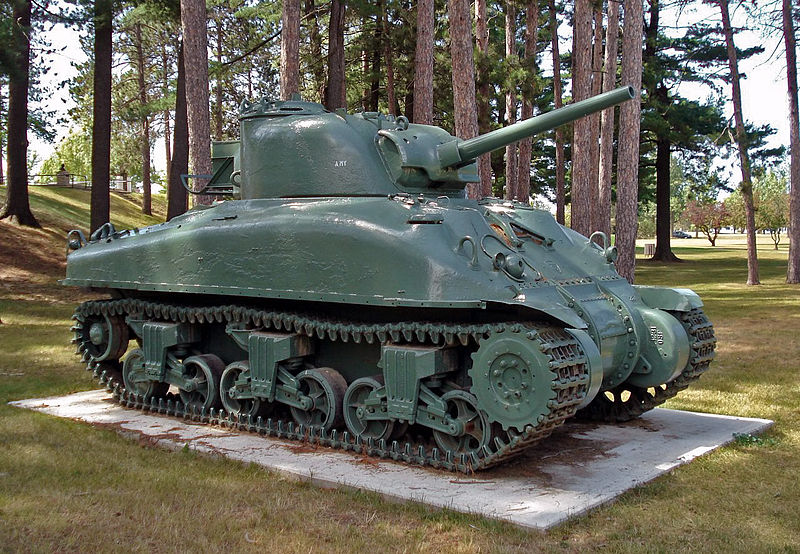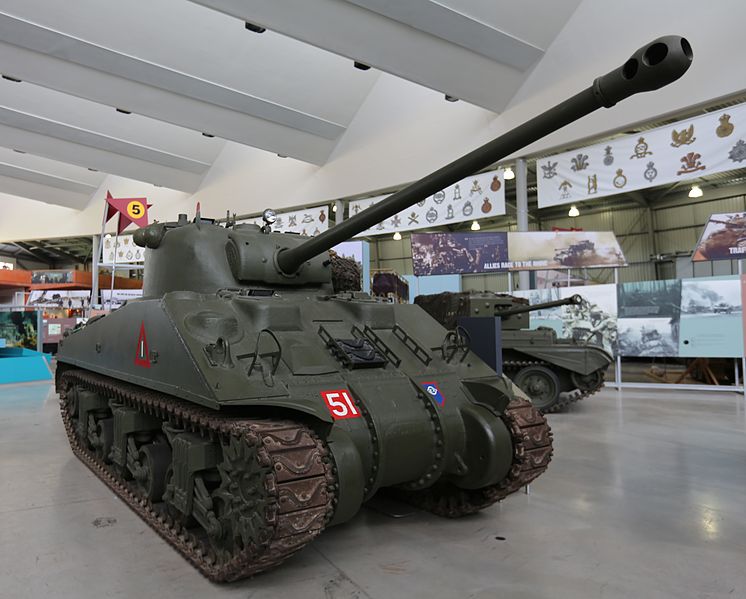Last month, Paul Richard Huard did a brief tribute to one of the iconic tanks of the Second World War, the M-4 Sherman. It was not a good tank, but it was good enough (if you ignore the survivability of the crews):

M4A1 Sherman tank at Canadian Forces Base Borden (via Wikipedia)
The M-4 Sherman was the workhorse medium tank of the U.S. Army and Marine Corps during World War II. It fought in every theater of operation — North Africa, the Pacific and Europe.
The Sherman was renown for its mechanical reliability, owing to its standardized parts and quality construction on the assembly line. It was roomy, easily repaired, easy to drive. It should have been the ideal tank.
But the Sherman was also a death trap.
Most tanks at the time ran on diesel, a safer and less flammable fuel than gasoline. The Sherman’s power plant was a 400-horsepower gas engine that, combined with the ammo on board, could transform the tank into a Hellish inferno after taking a hit.
All it took was a German adversary like the awe-inspiring Tiger tank with its 88-millimeter gun. One round could punch through the Sherman’s comparatively thin armor. If they were lucky, the tank’s five crew might have seconds to escape before they burned alive.
Hence, the Sherman’s grim nickname — Ronson, like the cigarette lighter, because “it lights up the first time, every time.”
Commonwealth units were allocated a proportion of Sherman tanks with the original 75mm or 76mm main gun replaced by a British 17-pounder anti-tank gun that gave Sherman Firefly tanks nearly the same punch as German Tiger tanks (and better than Panthers). There weren’t enough to go around, so they were parcelled out to allow a few Fireflies per troop or squadron. The 17-pounder gun also lacked a high explosive round for use against thin-skinned or unarmoured targets, so including one or two Fireflies among a group of conventionally armed Shermans was a good trade-off.





This is a somewhat mythical reputation. Although I am unable to come up with any solid articles right now, I know it’s been addressed several times by historians who work for the company that makes World of Tanks.
The only article I could find easily simply said that many German tanks also ran on gasoline and didn’t have fire-trap reputations (and it’s also a myth that 75mm Shermans [let alone 76mm or Firefly] were unable to penetrate Tigers and Panthers, so that’s not an explantion), and that that particular Ronson slogan didn’t launch until after the war.
But, yeah. No actual facts to back this up with…
Comment by Liam — November 15, 2014 @ 09:01
Not so much a “myth” as over-generalization of the facts. Compared to other tanks in the same era, the Sherman was reliable, easy to maintain, and very widely available. On the down-side, once hit, they tended to be more prone to fire damage and crew survival rates were lower than other tanks.
Myths are usually built on at least some foundation of fact, like this:
With stories like that, it’s no wonder that at least some allied tank crew considered their AFVs to be massively inferior to their German counterparts.
I posted several excerpts from a post by Nigel Davies back in August which at least touched on the role of the Sherman and Sherman Firefly:
Comment by Nicholas — November 15, 2014 @ 09:28
For counterpoint, there’s this forum post that also makes some interesting claims:
Comment by Nicholas — November 15, 2014 @ 09:38